Medical care in 2022 had all the ups and downs, ins and outs we have come to expect from this pandemic era. But our collective dedication to continuously strive towards the best possible care, most effective treatments, and innovations that grow access and confidence only expand further.
As the year comes to a close, we reflect on all that has been accomplished and all there is still left to do. One thing is certain, inspiration lives among us.
From the Lab to the O.R., Specialization Blooms
The Art of Surgery Brings Benefits in Breast Cancer Treatment
Breast surgeons can use two different techniques when performing lumpectomy. And it turns out that one is not better than the other, it's the surgeon's preference and technique that matters.
In the fall of 2022, Roshni Rao, MD, Chief of Breast Surgery, and breast surgeons Lisa Wiechmann, MD and Stacy K. Ugras MD, FACS, released the results of a two-year study that compared two techniques, cavity shave margins (CSM) and specimen shave margins (SSM), by analyzing positive rates of primary and final shaved margins, re-excision rates, and tissue volumes removed. The study found that “between the two methods, the need to re-excise, which would be based on a positive margin or a very close margin, is the same.”
“We’re constantly reassessing our own techniques and putting ourselves under the microscope to make sure we're doing the right thing. And not just doing what we think is right, but checking the evidence and the research and looking at our outcomes,” said Dr. Stacy Ugras.
Fixing a Little Boy’s Swiss Cheese Heart
Emile Bacha, MD, Pediatric Heart Surgeon and Chief of the Division of Cardiac, Thoracic, and Vascular Surgery, had tackled about twenty swiss cheese septums (‘swiss cheese’ refers to multiple ventricular septal defects) over the course of his career but he had never seen a case with as many apical VSDs as Maverick had. “That’s an area that’s sort of a no-man’s-land for surgeons,” says Dr. Bacha. “It’s very, very difficult to get to without damaging the heart.”
After being turned down for surgery by other institutions, Maverick finally found the “yes” his parents were desperately seeking. And despite the complexity, Dr. Bacha was able to report that the surgery went better than he could have hoped. Now in preschool, Maverick is healed, happy, active, and gets to grow up just like every other kid.
Immunotherapy Changes What’s Possible in Lung Cancer Treatment
Cancer is like a stealth fighter jet: it sneaks in and evades the immune system using receptors that block the body from recognizing it. And immunotherapy is the counterattack that “basically stops this hiding,” harnessing a person’s own immune system to recognize, locate, and destroy cancer cells. At least that’s how Joshua Sonett, MD, Chief of General Thoracic Surgery explains it.
“We generally have known for years that the healthier a person is, the better their immune system works,” says Dr. Sonett. “Now, we have medicines that help to really gear it up, to help the immune system naturally attack these cancers.” And the results have been remarkable. The best part is that immunotherapy doesn’t stand in the way of other treatments, it is used alongside them. A huge boon to treatment for those with lung cancer, especially non-small cell lung cancer.
Using Holograms to Guide Cardiac Interventions
New holographic imaging system allows cardiologists and cardiothoracic surgeons to project 3D images from an array of sources—CT to MRI and 3D ultrasound—right into the room, even placing the platform right above the patient to get an in-place view of the anatomy. By interacting with the hologram, surgeons can rotate and slice through the 3D projection to reveal any anatomical view. This tool quite literally transforms imaging ability, opening the door to complex procedures that previously were not possible.
Hiroo Takayama, MD, PhD, newly appointed Chief of Cardiac Surgery, is excited by the impact this technology will have on complex interventional procedures, both in advancing the interventions that already exist and aiding in the development of complex procedures yet to come—in the cath lab and beyond. There is so much more on the way from the #1 Heart Hospital in New York and #4 in the nation.
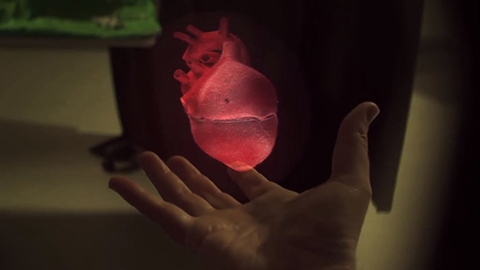
The Future is Now in Xenotransplantation
Transplanting animal organs into human bodies is something Megan Sykes, MD, Director of the Columbia Center for Translational Immunology, has viewed as a welcome challenge for 35 years. In that time she has seen the field progress so much that she believes xenotransplantation is going to be a medical reality sooner than we think, and that clinical trials will begin “within the next couple years.”
Xenotransplantation is about much more than achieving a procedure that feels a bit otherworldly. It’s a priority to many transplantation surgeons and experts because it could address many of the barriers that have existed in organ access for decades.
“There's really no successful model yet, but we want to start a real focus on this to make it possible in the next few years' time,” says Tomoaki Kato, MD, Chief of Abdominal Organ Transplantation and Surgical Director of Liver and Gastrointestinal Transplantation. “I've seen many young individuals to whom we cannot offer a liver transplant and they die. That's a real heartbreaking moment knowing that this patient could be helped, but we can't really offer it based on the availability issue.”
Pioneering Thyroid Treatment Expands Nationwide
65 percent of people will have a thyroid nodule in their lifetime; and 5 percent are cancer. This fact is what drives Jennifer Kuo, MD, thyroid surgeon, to train and educate thyroid surgeons and endocrinologists nationwide in the importance of interventional endocrinology. The anchor is a philosophy: less is more. An approach bolstered by cutting edge non-surgical treatments like radiofrequency ablation, or RFA, where surgeons can target the nodule and spare the surrounding tissue in an out-patient setting.
A New Way to Treat Rare Cancers
While Scott Yanke was being treated for dedifferentiated liposarcoma, a rare cancer that forms from the body’s fat cells. His tumor was retroperitoneal, meaning it was in his abdomen, pressed right up against his intestine; surrounded by critical organs like his kidney, ureter, and pancreas, which made it difficult to treat, especially with radiation. And yet, throughout his treatment, he said he was indoor skydiving “a whole bunch.”
The reason that he felt so good had everything to do with a relatively new and innovative treatment called proton beam therapy. “Proton beam radiation is just a more accurate way of delivering radiation,” says Sam Yoon, MD, Chief of the Division of Surgical Oncology and the doctor who treated Scott’s cancer. “Proton radiation uses protons, which are particles. And the way that the particle energy is delivered is that when the particle leaves the machine, the energy is about the same when it leaves the machine as it is when it hits the target. And then, you can stop a proton immediately beyond the tumor. So we generally say that there's less entrance dose and almost no exit dose of radiation.” Having just completed phase II of a trial, Dr. Yoon is on a mission to get proton beam radiation available more widely and more readily so others can share in Scott’s experience.
Community Is an Action Word
On a Mission to Fix Kid’s Hearts in Nigeria
Nigeria has virtually zero cardiac care for children with congenital heart disease. On average, there are 10 operations a year performed on children in a population of 211 million people. Earlier this year a pediatric heart surgery team, led by Andrew Goldstone, MD, pediatric heart surgeon, joined the Vincent Obioma Ohaju Memorial (VOOM) Foundation to “Bring Columbia to Nigeria,” as Dr. Goldstone put it.
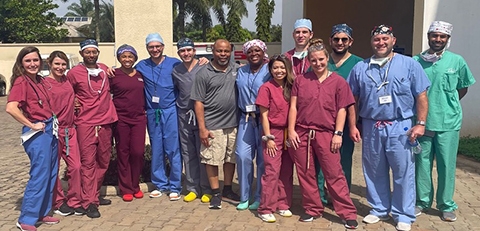
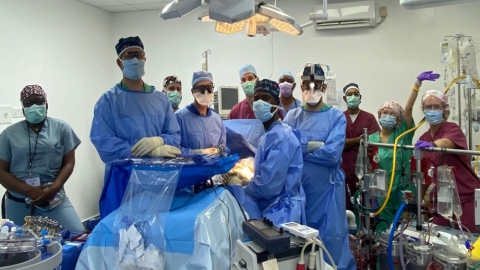
They successfully operated on 14 children with complex congenital heart disease on their 10-day visit, exceeding the yearly average in a single trip. It was such an impactful and rewarding experience that the team plans to go back every year to operate, teach the teams on the ground new surgical techniques, and establish standards of care.
“It's very easy as a physician in the United States, especially in New York I think, to get caught up in the stuff outside of medicine because we're hounded by it—whether documentation, billing, et cetera,” he says. “This reminded me of why I became a doctor. Just helping people. It makes me appreciate my job all the more coming back.”
A Reason for Hope in Treatment of Pancreatic Cancer
Every year we host an important event, Pancreatic Cancer Awareness Day. Seventeen years running, it’s a time for patients, their families, and care teams to come together in support and celebration. This year was the first time we had the event in person since before the pandemic, making the day even more special.
John Chabot, MD, Director of the Pancreas Center spoke on all the latest advances in treatment, along with many other experts who shared cutting-edge clinical trials and research developments. Most importantly, patients shared advice, stories (both triumphs and difficulties), and strengthened bonds.
Establishing a Peer Support Program for Surgeons
When things go wrong in the operating room, it can have lasting effects on everyone involved. For surgeons involved in adverse outcomes, the aftermath can be overwhelmed by feelings of grief and guilt. “The circumstances of taking care of really sick people every day, where so many things can go wrong, is that if they do go wrong, the first thing a surgeon will do is internalize it,” says Steven Stylianos, MD, Chief of Pediatric Surgery.
As research and understanding of mental health have grown, the medical community has recognized the importance of processing difficult emotions that come with the job. Both to help the surgeon, and to ensure patients continue receiving top-notch care. A new peer support program at Columbia, championed by Dr. Stylianos, lets surgeons process adverse events in a supportive, stigma-free setting. A win for us all.
Bringing Spanish to the Forefront
According to recent data, over 60 percent of the households in our community of Inwood speak Spanish, but we don’t need data to provide what we already know by living and working in the neighborhood. And it’s high time digital access caught up to our patients closest to home. That’s why, in addition to adding more and more Spanish-speaking surgeons to our faculty, we’re starting to translate the content on our website as well. Here’s all the latest in bariatric surgery, or Cirugía para Obesidad en el año 2022.
The Facts About Gender Identity Care Reach a Wider Audience
At this moment it’s important to state unequivocally that legislation that bans or limits access to gender-affirming treatments for trans and non-binary youth is dangerous and runs counter to scientific evidence. To reinforce the importance of treatment and provide a space for kids and their families, we hosted an Instagram chat and Q&A session.
Melina Wald, PhD, Clinical Director of the Gender Identity Program, Christine Rohde, MD, Chief of Plastic Surgery, and plastic surgeon Jeffery Ascherman, MD, discussed various aspects of treatment, insurance issues, medical therapy, surgical interventions, and collaboration.
A Day of Joy for Those with Craniofacial Differences
This summer families traveled from all over the country to come together in celebration of their children born with cleft lip and cleft palate. It was a day to share stories and experiences, the latest in craniofacial treatment, and most importantly have fun and share joy. A beautiful event Thomas Imahiyerobo, MD, Director of Cleft and Craniofacial Surgery, intends to continue year after year.
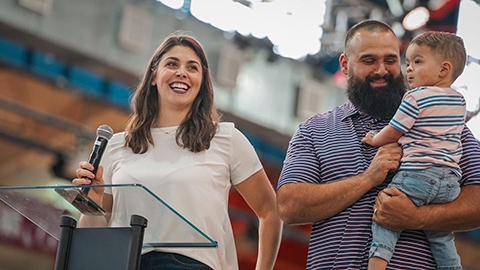
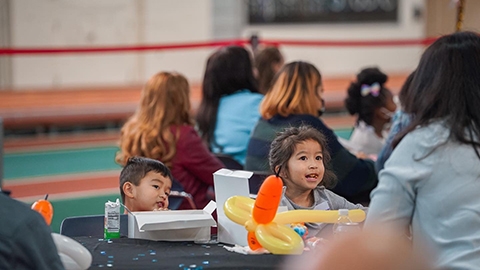
The Story of Two Heart Transplants Told Through Art on Social Media
Gianna Paniagua took over our Twitter account to talk about her experiences getting a second heart transplant after 28 years with her first heart transplant as a toddler in 1992. She's a 29.5-year-old Cuban papercutting sculptor from New York City and is also currently a post-bac premed student at Columbia.
For Gianna, artmaking is like breathing. And there have been periods of time when her body couldn’t allow her to do it. Her journey, expressed through comics and sculpture, holds so much wisdom—as a patient, an artist, and a human navigating the world with medical issues most can’t see or understand. A two-day takeover with seemingly endless enduring value.
Hi I’m Gianna! Today I’ll be taking over to talk about my experiences getting a 2nd heart transplant @VUMCtransplant after 28 yrs with my 1st from @nyphospital/@ColumbiaMed in 1992. I’m a Cuban papercutting sculptor from NYC & currently @ColumbiaGS as a postbac premed. #GiannaTX pic.twitter.com/Ad3SNHgksX
— Columbia Surgery (@ColumbiaSurgery) February 24, 2022
How Siblings Use a Family Approach in Pediatric Surgery
Critical care pediatric nurse Lisa Richardson and Chief of Pediatric Surgery Steven Stylianos, MD, have worked together at NYP/Columbia for over 25 years. But they’ve known each other a lot longer than that. A lifelong knowledge, in fact: they’re siblings.
Dr. Stylianos will operate on a child and bring them up to the ICU, where Ms. Richardson takes over their care, helping to guide their families through the recovery process. It’s something that, year after year, brings families immense comfort as their children recover from surgery. If they share one thing, it’s the pride they feel in helping others and doing good work.
“We kid each other a lot, but I think the depths of our pride for one another—you can’t quantify it. I've said it privately and publicly, I think she's one of the best nurses in the hospital. And she's probably pretty proud of what I do, too,” said Dr. Stylianos.
Growth and Expansion
A Better Reflection of Care in Westchester
The power in a name has taken several forms this year. The most recognizable being the unveiling of NewYork-Presbyterian Westchester, formally Lawrence Hospital. With this new name we aim to reinforce our commitment to the local community and extend the highest quality care you have come to know in more convenient locations, close to home. And we’ve already started the growing surgical-specific care there too with the opening of our Cardiac Surgery Clinic in White Plains.
Not All Hernia Repair Is Created Equal
A new division was born in 2022, and it’s been a long time coming. The Columbia Hernia Center has a new worthy home in The Division of Abdominal Wall Surgery, one of the only divisions in the country solely dedicated to advancing the most innovative surgical hernia care—through treatment, education, research, and standardization of care. As Yuri Novitsky, MD, Director of the Hernia Center and President of the American Hernia Society says, “Hernia surgery is not ‘anybody’s’ game.” It requires the same level of dedication as any other specialty.
“The desire to produce better results, the ever-growing complexity of disease and options that were being offered, it became obvious that you need to be fully invested. I would like the field of hernia and abdominal surgery to follow that path and in the next five, ten years, become a widely recognized and established subspecialty of surgery,” said Dr. Yuri Novitsky.
Treating Generations of Families Starts with Dedication and Compassion
Hereditary colorectal cancer is complex. It grows quickly, often doesn’t show symptoms early, and is transmitted through generations of families. That’s why this year we opened The Columbia Hereditary Colorectal Cancer Center. A center dedicated to providing continuous and family-specific treatment as well as an institute to pass down the technique and principles of treatment developed by James Church, MD, Director of The Columbia Hereditary Colorectal Cancer Center and a world-recognized pioneer of the field.
Kidney Autotransplant Program Brings New Treatment to the Fore
Liken it to giving yourself your own kidney transplant. Kidney autotransplantation is an innovative minimally-invasive procedure in which the kidney is removed from its normal location and moved into the pelvis.
The procedure has benefits for those with various kidney diseases. For some conditions, such as complex renal artery aneurysm, ureteral tumors, and ureteral injuries, the kidney is fully removed from the body and repaired before being re-transplanted. For others such as LPHS or nutcracker syndrome, the act of repositioning the kidney alone is beneficial itself. Earlier this year, we brought together kidney transplant surgeons, vascular surgeons, and urologists to create the first dedicated Kidney Autotransplant Program in the Northeast.

